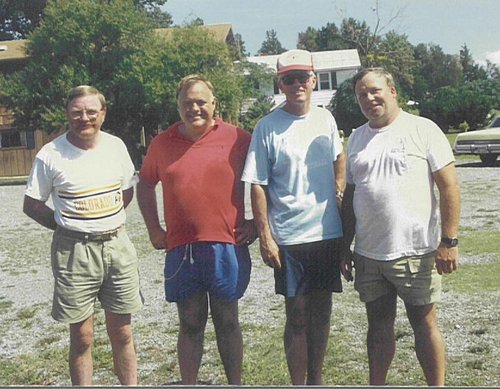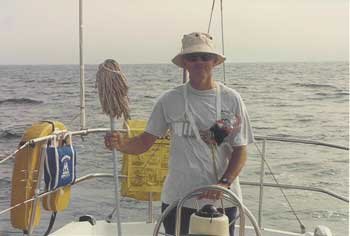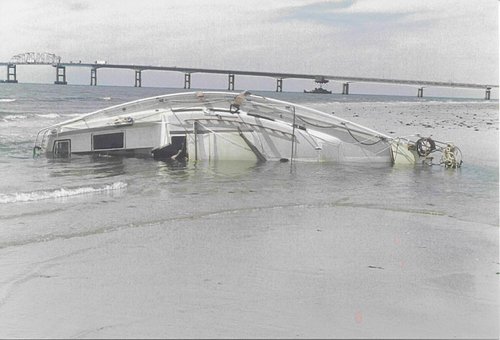FBYC Disaster at Sea...
Jere Dennison
There is an ancient nautical superstition that, if a sea voyage shall commence on a Friday, disaster will befall the hapless vessel. On Friday, September 14, 1990, the FBYC-flagged S/V Fugue departed Ruarks Marina on Fishing Bay bound for a circumnavigation around Cape Hatteras and return to Chesapeake Bay via the Intracoastal Waterway. Less than four days later, her battered and broken hull washed ashore on a desolate island off the Virginia Capes, a total loss. This is her story.
I was privileged to attend the first annual reunion of the crew of the Catalina 30 Fugue in 13 years. (13 years! - yikes, another bad omen.) Spread over the table on the porch of the Tavern in West End Richmond were a stack of photographs, documents, and other assorted memorabilia from their fateful voyage in September 1990. The crew included FBYC members Sam Marshall (owner/skipper of the Fugue), Brooks Zerkel, George Patteson (former FBYC Treasurer), and a fourth, Jim Campbell, a non-member.
 |
| The Survivors (L to R): Campbell, Marshall, Patteson, and Zerkel |
All were experienced sailors and sailboat owners. Sam had owned several sailing vessels, and, during the 1960s had captained a Tahitian sloop down the East Coast, through the Panama Canal, up the West Coast to Washington State, and over the Pacific to Hawaii. The entire four-man crew had enjoyed a delightful and uneventful circumnavigation of the Delmarva Peninsula on the Fugue in 1989 and decided the following year to repeat this enjoyable blue-water sailing experience by challenging Cape Hatteras and circumnavigating through the inland waterways of North Carolina and Virginia before returning to Fugues homeport in Deltaville. In spite of Cape Hatteras reputation as the Graveyard of the Atlantic and its location within the feared Bermuda Triangle, the gallant crew was undaunted. The cruise was meticulously organized down to float plans, menus, and shipboard duties. All the plans were reduced to writing for distribution to the crew and their families. No detail of the voyage was overlooked...except for the events that actually unfolded.
The weather looked favorable so the Fugue departed from its berth at Ruarks Marina on the evening of September 14, 1990...a Friday. The Bay was a bit rough as the Fugue motored south against a stiff headwind in order to maintain a schedule that would adhere to the float plan. One of the crew, experiencing a first day bout of mal-de-mer, was tossed from his bunk in the choppy seas and sustained a nasty gash on his head. With blood flowing copiously below, the Fugue detoured into Cape Charles City for some possible medical attention to its wounded crewmember. This was to be the first of a chain of misfortunes that was to befall the Fugue, but the crewmember recovered after a short respite ashore without medical assistance. Little did the crew know, but their second misfortune was about to occur. The skipper decided to top off his diesel tanks with fuel from the pier on which they had parked. This would reward the owner of the marina for his hospitality while replenishing fuel that had been consumed slogging to the mouth of the Bay. A win-win situation? Hardly. The fuel was dirty, as they were later to discover.
The wind having gone light, the Fugue motored through the Chesapeake Bay Bridge Tunnel and out into the Atlantic beyond the Virginia Capes on Saturday, September 15. That night the engine coughed, sputtered, and died. Misfortune number three had occurred. Changing the fuel filters did not help-they soon clogged again with contaminated fuel. With no replacements to be had, the Fugue drifted on a flat, nearly windless sea about 30 miles off due east of Currituck Sound off the North Carolina coast. Being a considerable distance from Cape Hatteras and not wishing to run the hazardous North Carolina inlets without the services of the iron jenny, the skipper prudently decided to scrub the mission. He turned the Fugue north, back to the Virginia Capes where the Bay would be easily accessible under sail alone.
 |
| Helmsman Patteson standing watch with companion |
So through the night and into the next day, the Fugue crept slowly up the coast in the predominating gentle breezes. During the evening of September 16, the wind increased moderately but the task of navigating the main ship channels over the Chesapeake Bay Bridge Tunnel was considered too risky without an engine. Instead, as night fell, she steered for the bridge near Fishermans Island at the north end of the Bridge Tunnel where boat traffic was expected to be light and no large ships would be encountered.
With the visual confusion caused by bridge lights, vehicle lights, navigational beacons, and assorted marine traffic, the Fugue wandered off course and struck the shallows south of Fishermans Island with the bridge in sight. She was hard aground and going nowhere in spite of heroic efforts to kedge her off the bar, some 25 yards from the undeveloped island, designated as a National Wildlife Refuge. The Fugue had experienced her fourth misfortune.
In no apparent danger with existing weather and sea conditions, the Coast Guard was hailed on the VHF and advised of their predicament. Accordingly, the Coast Guard, which had recently eschewed the business of towing distressed vessels, dispatched Sea Tow to the scene. Incredibly the fifth misfortune occurred as Sea Tow sustained prop damage when it hit a crabpot during its trip from Willoughby Spit to rescue the marooned vessel. Sea Tow would have to return to port for repairs before attempting to dislodge the Fugue the next morning.
 |
| Able-bodies seaman and cook Zerkel observing the eye of the storm |
Although there was no real cause for concern, the Coast Guard asked the skipper if he was declaring an emergency as such would cause the CG to spring into rescue mode. But conscientiously the skipper could not do so since the Fugue rested benignly on the sandy bottom, just a few yards offshore of the island. They had ample provisions to wait out the night in the calm and tranquil conditions. However, not declaring an emergency was to be the sixth misfortune to befall the Fugue for lurking in the Carolinas was a stationary autumnal cold front that suddenly began to track northward at a rapid rate. Early in the morning hours of the September 17, a gale rolled over the Virginia Capes with fierce 35 45 knot winds from the southeast, ferociously pounding the Fugue as she lay helplessly entrapped on a lee shore. In a matter of minutes, the sea raged with breaking 6-foot seas. The storm represented the seventh misfortune.
All hell broke loose below as the Fugue lifted and then dropped on her keel in response to the tumultuous seas. Thunderous waves broke over the stern sending torrents of water through gaps in the companionway boards and as far forward as the v-berth. But the crew dealt calmly with the confusion below as water rose to knee level and made hourly contact with the Coast Guard to apprise them of their situation. Climactically, at 4:30 AM, the boat rose ominously and descended hard upon its keel separating it from the hull. Simultaneously, the hull cracked open like an eggshell, and Fugue careened onto her starboard side. Now eye-deep in rising waters below, the crew did not hesitate obeying an abandon ship order from the skipper. Already adorned in PFDs and safety gear since the grounding, the crews quickly removed the companionway boards to confront breaking waves and water now over their heads. Using the Fugue as a breakwater, they made their way safely through the roiling surf to the shore of Fishermans Island as the dawning light mercifully appeared in the east. The eighth misfortune had befallen in a big way.
 |
| Fugue R.I.P. |
The beach around the Fugue soon became littered with flotsam from the wreck...just about everything in the cabin was scoured out by the waves that crashed over and through her. This was not a pretty sight, especially to the Fish and Wildlife officials who expediently appeared to charge the skipper with illegally landing on a wildlife refuge and despoiling the pristine beaches with the contents of the boat. The expression "adding insult to injury" comes to mind. Count this as the ninth misfortune.
But incredibly the story ends on a happier note. The Coast Guard eventually intervened on behalf of the sodden castaways, and all environmental charges were dropped. None of the crew was injured, just a little worse for wear. Insurance paid off generously for the loss of the vessel and personal gear. So is the evidence conclusive that embarking on a sea voyage on Friday is bad luck? By the skipper"s own calculations, the Fugue would have been off the notorious Cape Hatteras when the gale struck if everything had gone according to the original float plan, and, perhaps, the boat and crew would have found themselves in even greater jeopardy on the high seas, many miles from assistance. Friday departures unlucky? you decide.